
Continuing our spotlight on electric vehicle companies you may not have heard about yet is Canoo ($GOEV). The California-based EV startup in beautiful south bay is beginning to ramp up production of multiple electric vehicles. With two EVs unveiled and more on the horizon, Canoo is an electric vehicle company to keep an eye on.
Evelozcity before Canoo
Canoo was originally founded in 2017 by two former employees of rival EV automaker, Faraday Future. Ulrich Kranz and Stefan Krause originally called the new startup Evelozcity. Within two years, however, the founders decided to pivot to something a bit more simple. According to Stefan Krause,
We picked Canoo because it sounds distinctive, looks cool and creates a feeling of both relaxation and movement. For thousands of years, a canoe has been a simple, sustainable transportation device used all over the world.
Later that year, Canoo unveiled its first electric vehicle, an electric passenger van by the same name. The Canoo looks like something out of Westworld. It immediately set the tone for the brand’s futuristic vision toward its vehicles. Canoo focuses on minimalist design and utilizing space wherever possible, rather than compartmentalizing different parts of the vehicle.
In early 2020, the Canoo electric van caught the eye of Hyundai Motor Group. It quickly announced plans to jointly develop an electric vehicle platform for future Hyundai and Kia vehicles. Furthermore, the proprietary skateboard platform will offer a skeleton to multiple electric vehicle components stacked atop it. This is due in part to its “drive by wire” steering, meaning there is no traditional steering column, just connectors. It will allow companies to move the steering wheel wherever desired to better fit the body sitting upon it.
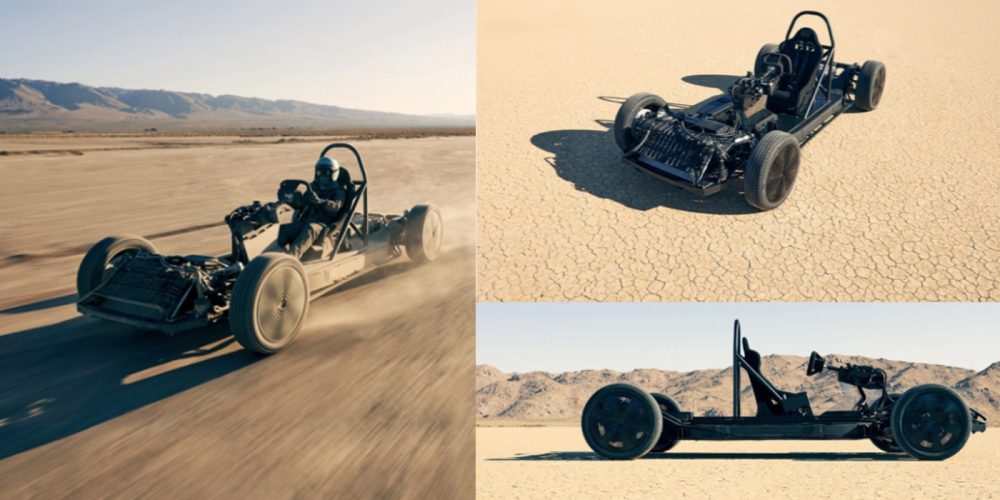
Canoo’s funding momentum continued to snowball throughout 2020. By fall, it announced a pending merger with Special Purpose Acquisition Company (SPAC) Hennessy Capital Acquisition Corp. IV. The merger was completed two months later, at a valuation of $2.4 billion. Canoo is now listed on the NASDAQ as $GOEV.
The Canoo electric van
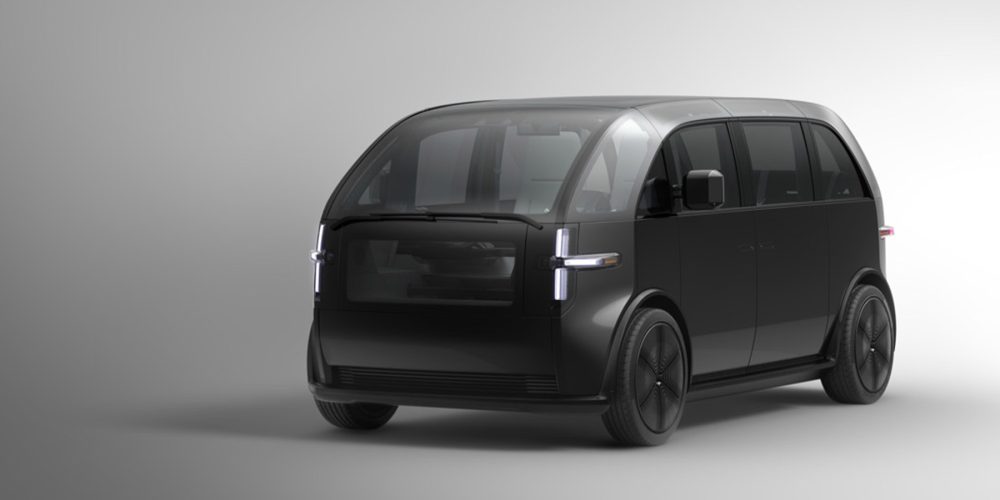
With the support of South Korean automakers and Wall Street, Canoo has spent the last year building toward the delivery of its first EV, The Canoo.
Canoo’s passenger van utilizes maximum cabin space while still sitting atop its modular EV platform. This gives it the footprint of a compact electric vehicle, with the interior of an SUV. The exterior features 22 windows, offering enhanced light and visibility for passengers and drivers. According to its website, the Canoo will only be available in black. Nevertheless, Canoo says endless vehicle wraps will allow owners to customize their EV however they’d like.
Moving inward, the Canoo’s interior is designed to feel more like furniture than car seats. With room for seven, the backseat feels like an ultra-modern breakfast nook or a glass limousine.
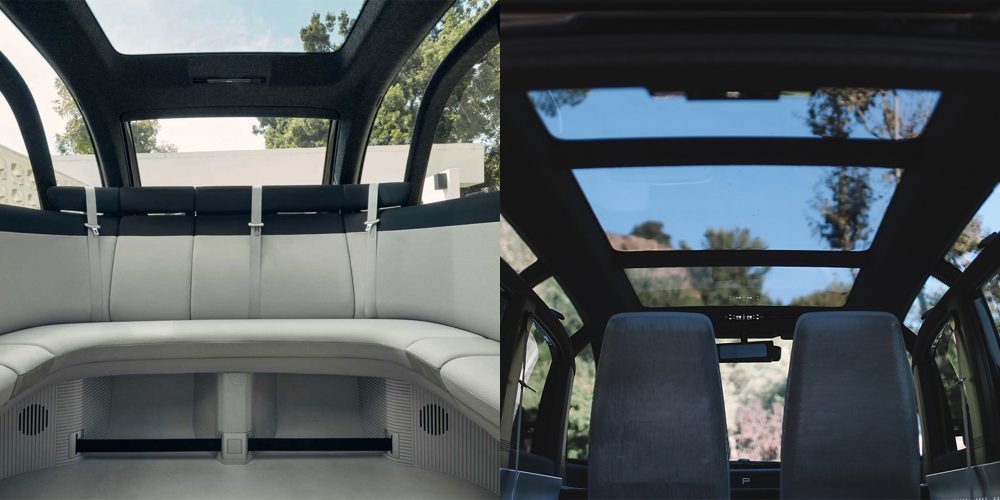
Up front is minimalist indeed. The information panels exist between the windshields and the glass roof, but are concealed by fabric. Data such as range and speed is illuminated through the fabric when the car is operating.
What is most unique about the Canoo van is that it has zero screens. Where current EV automakers are adding larger touchscreens, plus screens for drivers and passengers, Canoo has gone the opposite direction. Instead, the EV offers seamless connectivity to your smartphone using the Canoo app. There is a dock in the center of the dash to hold it in place as well (not visible below).
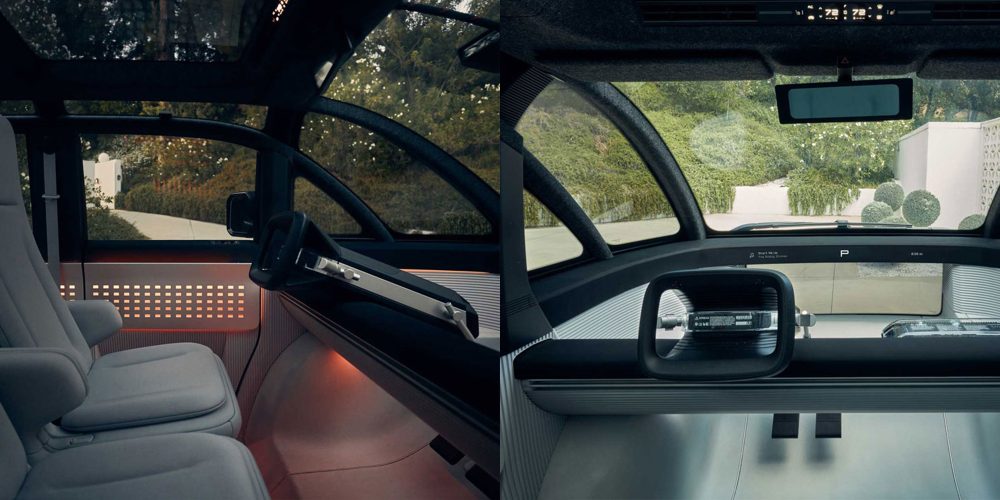
Canoo electric van specs
According to the full specs on Canoo’s website, this van will operate with rear-wheel drive on a single, magnet synchronous electric motor. The motor will offer 300 horsepower and 2,803 ft-lbs of peak torque. Its 80 kWh battery pack offers 250 miles of range and can charge to 80% capacity in 28 minutes using DC fast charging.
The Canoo will be able to reach a top speed of 125 mph and travel 0-60 mph in 6.3 seconds. Consisting of 90% steel, the electric van weighs about 4,450 lbs.
Lastly, these specs are for the RWD single motor, but the Canoo website briefly mentions an AWD powertrain. However, Canoo has not yet offered any further specs.
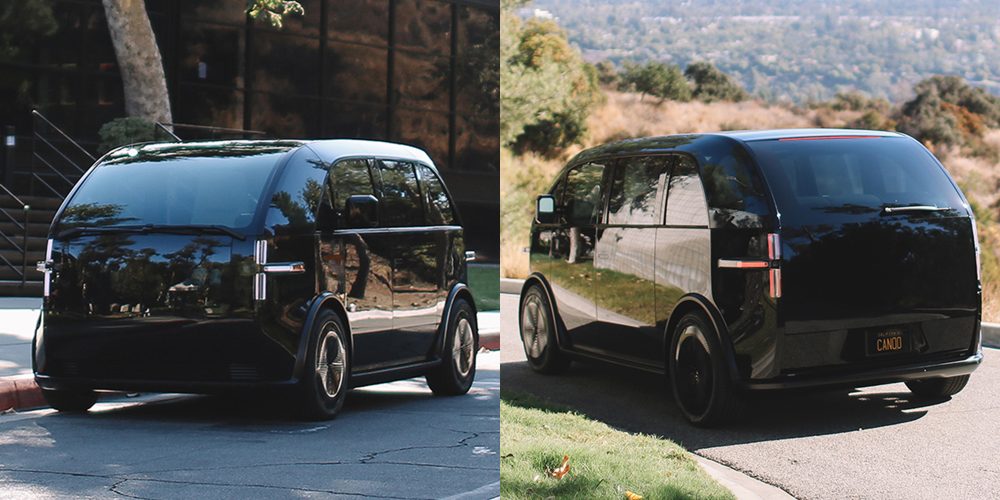
The Canoo will be a subscription EV
Apart from its overall look, the Canoo is also unique in that it is a subscription-based EV. The Canoo membership will offer a month-to-month and commitment-free alternative to owning or leasing a car.
Canoo members will receive 24/7 access to their personal Canoo, as well as additional services like charging, maintenance, and insurance. All these features would be included for a single monthly payment. Canoo has not yet revealed what this subscription model may run you each month. That being said, if the price is right, it could be worth testing out.
Currently, the Canoo electric van is scheduled to launch sometime in the second quarter of 2022. For now, prospective customers can join a waitlist to get first dibs when they do deliver.
Canoo’s Multi-Purpose Delivery Vehicle (MPDV)
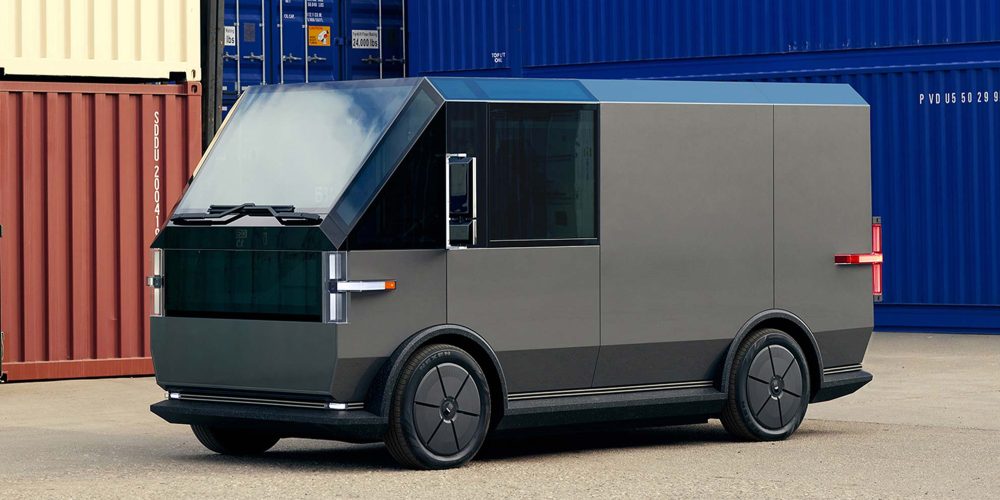
The most recent electric vehicle unveiled by Canoo is its MPDV, an all-purpose, modular delivery van. The MPDV sits on the same Canoo platform, but with a much different body catered toward deliveries and business owners.
According to Executive Chairman Tony Aquila during the MPDV unveiling, Canoo wanted the EV to appear very smart, but affordable. Its purpose is to serve as a power plant for business owners to pull up, plug-in, and immediately “do their thing.”
The MPDV was built from the inside out with the users of the EV in mind throughout the development process. As restauranteur Roy Choi phrases it in the video, “it’s like an RV, a van, a delivery truck. Everything all-in-one.” That’s a solid summation from what Canoo has revealed about the MPDV thus far. You can watch the entire unveiling from last December right here:
MPDV Exterior
The overall design of the multi-purpose delivery vehicle is both form and function for the working class. Its plug-and-go features offer fully customizable plug-ins to fit your needs. That means no more noisy generators. Customers can have 120- or 240-volt outlets on either side of the exterior, or realistically anywhere else they’d like.
The MPDV’s flat panels throughout the exterior offer owners their own billboard on wheels. They can wrap or design these panels however they’d like, to advertise their business or catch the eye of passersby.
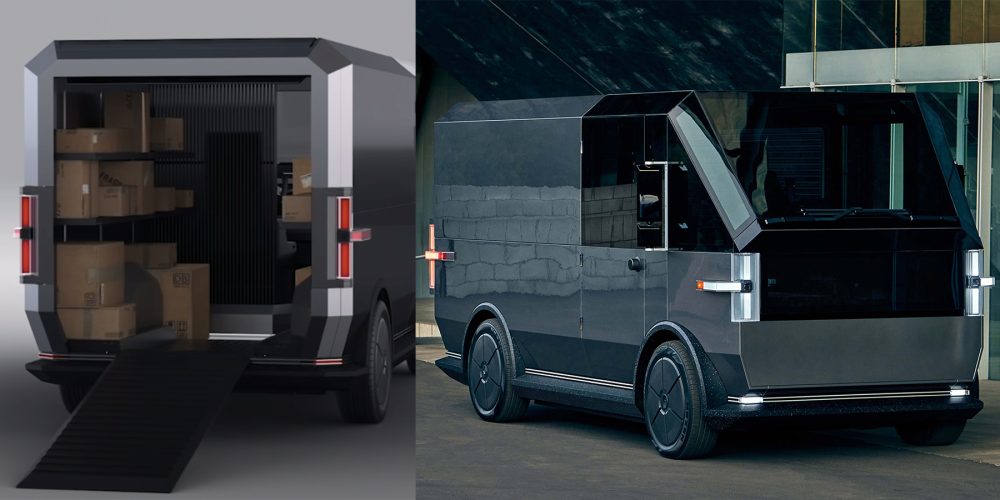
Currently, Canoo has listed two size variations for the MPDV with a third in development. The MPDV1 is 14.4ft x 6.4ft x 6.2ft and offers 230 cubic feet of cargo space, including the front cabin. Depending on the battery capacity, it can haul a payload between 1,540 to 1,980 pounds.
The MPDV2 is larger at 17.1ft x 7.2ft x 8.4ft, although it sits on the same platform. This version offers 500 cubic feet of total cargo and can haul between 1,320 and 1,760 pounds.
MPDV Interior
Moving inward, there is a clear focus on sleekness, functionality, and durability. The front cabin does not contain a lot of gadgets. Three phone-like screens offer various pieces of data pertinent to drivers.
According to Tony Aquila, the Canoo lineup was strategically built as a technology platform to not only aid customization, but future innovation. The software within the MPDV is geo located. This can help business owners like food trucks, for instance, keep their customer base informed of its location in real-time. That means no more having to look up hours on social media and hoping the truck is actually there.
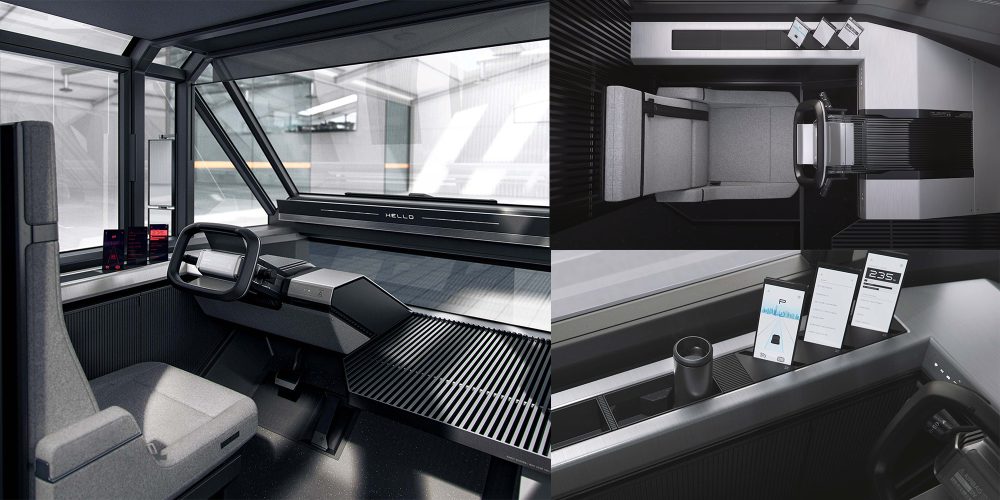
Additionally, the Canoo platform is operating under level 2.5 autonomy, assisting drivers in safely avoiding danger on roads. Aquila states that as autonomous technologies continue to advance, Canoo will be able to easily incorporate them on its technology platform using over-the-air software updates.
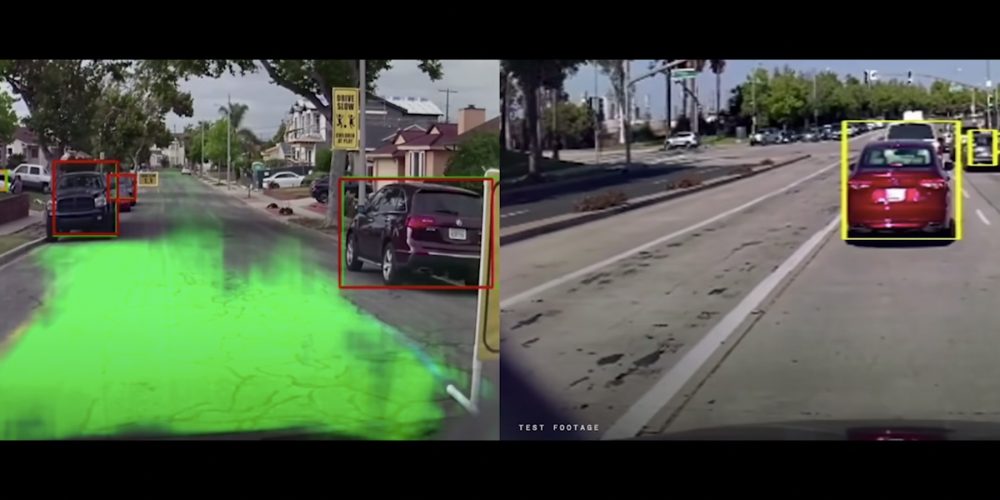
Moving toward the rear, the clear focus is function. The unveiling video points out that a grown man can stand in the back without having to duck or crouch. Additionally, the rear is better lit with natural light from the all-glass front. This offers anyone in the back more visibility and that vital vitamin-D.
What is most unique and exciting about the MPDVs in particular is the modular capabilities. With the working class in mind, Canoo designed this multi-purpose vehicle to be customized by each and every customer. Whether it’s a live-in camper, a food truck, or an apparel mart on wheels, the top half of MPDV can be reconfigured and designed to offer owners everything they need.
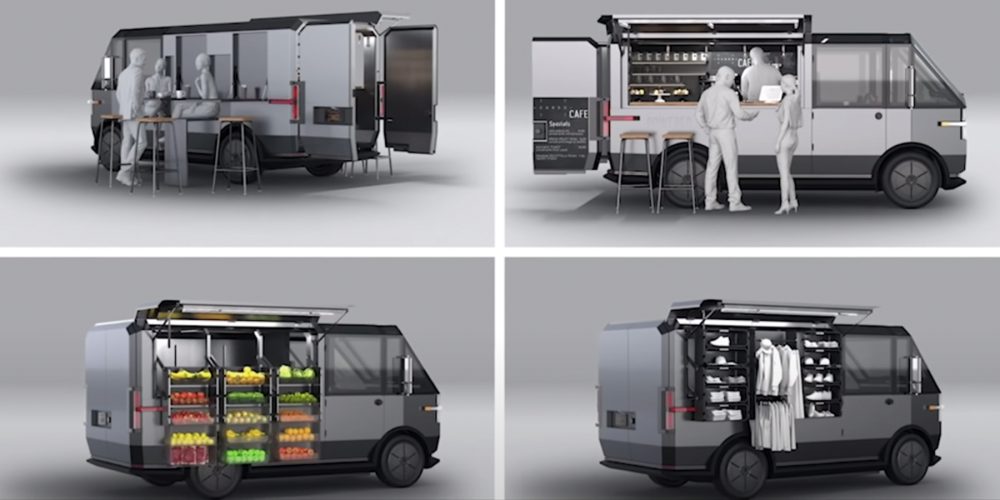
Specs for the MPDV1 and MPDV2
We’ve already touched on the variations in size and cargo space between the two MPDVs currently announced by Canoo. Next, let’s dig into the performance and range.
The MPDVs offer front-wheel drive from one permanent magnet synchronous electric motor. The motor offers 200 horsepower and comes with three battery options: 40, 60, or 80 kWh.
Starting with the MPDV1, the EPA estimated ranges are as follows: 130 miles on the 40 kWh battery, 190 mi on 60 kWh, and 230 mi on 80 kWh. The MPDV2 can travel 90 miles on a 40 kWh battery, 140 mi on 60 kWh, and 190 mi on the 80 kWh.
Lastly, let’s talk pricing. While the Canoo van will be a monthly subscription, the MPDV will be available for purchase due to its fully custom abilities. The MPDV1 starts at just $33,000 and goes upwards based on custom modifications. It is currently available for pre-order with a $100, refundable deposit. The automaker has previously said a limited rollout of the MPDVs will begin in 2022, with scaled production and launch slated for 2023.
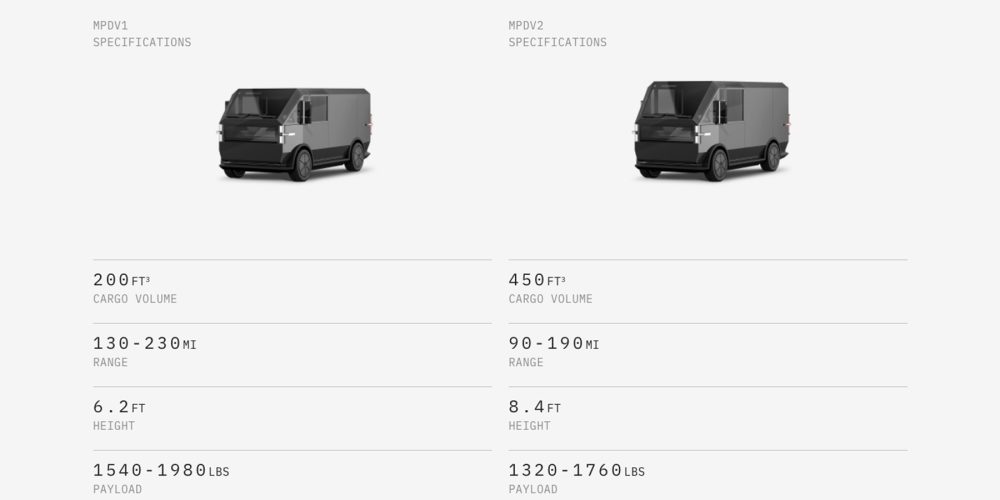
The future for electric vehicle companies like Canoo
While Canoo has yet to release its first electric vehicle, the prospect of its unique approach to the market remains exciting. It will be interesting to see how Canoo’s van subscription model will work and if it will find success. If it does, we will keep an eye on the EV market and see if any competitors adopt a similar strategy.
The automaker will begin rolling out its first EVs in the US next year. It also plans to expand to the rest of North American and eventually Europe. In addition to its electric van and two versions of the MPDV, Canoo has an even larger MPDV3 being developed.
Lastly, at the end of the MPDV unveiling video, Tony Aquila and Roy Choi ride off, and behind them sit two more prototype EVs covered in black sheets. While it’s impossible to tell exactly what they are, one is shaped like a sedan and the other, a pickup truck. Their black silhouettes are also featured on the Canoo website as “coming soon.” While they are still prototypes, it’s encouraging to see the American automaker with two more potential EV offerings in its pipeline.
That’s it for Canoo for now. Keep an eye out for future updates on the company from Electrek. Furthermore, check back soon for more spotlight articles on electric vehicle companies like Canoo, that you may or may not have heard of yet.
Subscribe to Electrek on YouTube for exclusive videos and subscribe to the podcast.
Author: Scooter Doll
Source: Electrek



